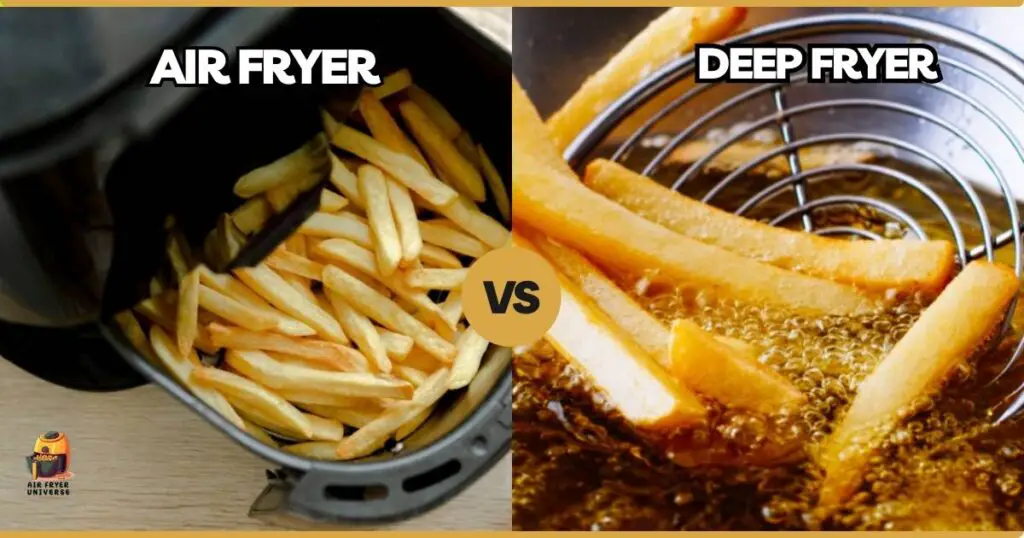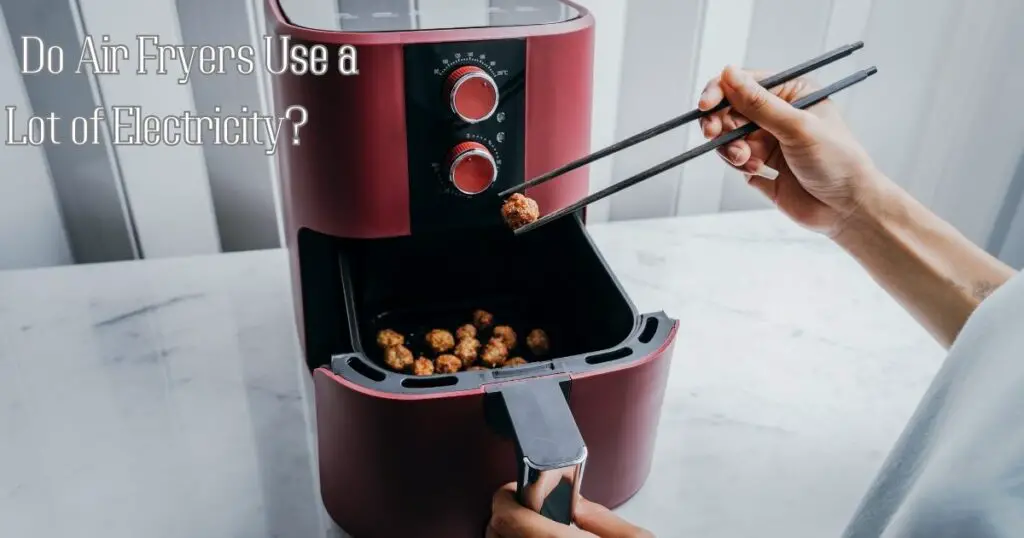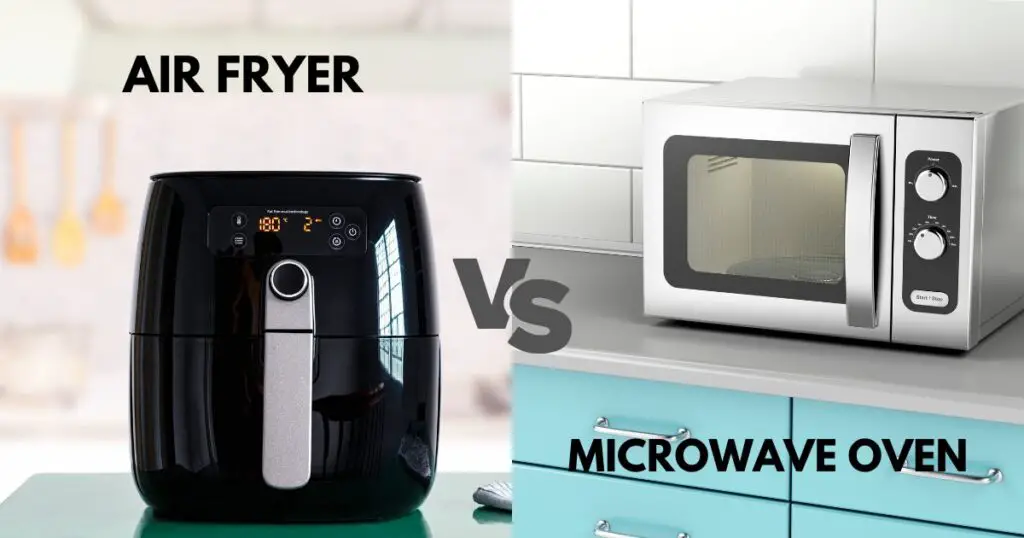Table Of Contents
In the realm of kitchen appliances, two culinary powerhouses often take centre stage: the air fryer and the deep fryer. These kitchen workhorses promise to elevate your meals with their distinct cooking methods.
The air fryer relies on hot air circulation and a minimal amount of oil to create healthier versions of favourites like french fries and chicken wings. On the other hand, the deep fryer immerses food in sizzling hot oil, delivering the indulgent, crispy texture associated with beloved comfort foods.
So, which one is the better fit for your kitchen and your culinary aspirations? Let’s dive into the details to help you make an informed decision.

What is Deep Frying?
Deep frying is a cooking method that involves submerging food entirely in hot oil to cook it. The high temperature of the oil quickly cooks the exterior, creating a crispy texture, while the moisture inside the food turns to steam, cooking the interior.
This process results in food that is crispy on the outside and tender on the inside, often associated with classic fried dishes like chicken, french fries, and doughnuts.
How Do Deep Fryers Work?
Deep fryers are kitchen appliances designed for frying food by submerging it in hot oil. Here’s an in-depth explanation of how they work:
Heating Element
Deep fryers are equipped with a powerful heating element, which can be either electric or gas-powered. This element is situated beneath the oil reservoir and is responsible for generating and maintaining the high cooking temperature required for frying.
Oil Reservoir
The fryer contains a dedicated oil reservoir or chamber where a specific amount of cooking oil is added. The size and capacity of the oil reservoir vary depending on the fryer’s design and purpose.
Thermostat
Deep fryers feature a built-in thermostat that allows users to set and precisely control the cooking temperature. This thermostat ensures that the oil remains at the desired heat level throughout the entire frying process, resulting in consistent and well-cooked food.
Oil Immersion
Food intended for frying is carefully placed into a basket, often equipped with a handle, which is then lowered into the hot oil. It is essential that the food is fully immersed in the oil to guarantee even cooking and achieve that desired crispy, golden-brown exterior.
Cooking Process
When food is submerged in the hot oil, several essential processes take place:
- The high cooking heat quickly cooks the outer layer of the food, creating a crispy and visually appealing golden-brown crust.
- As the food cooks, the moisture inside it turns into steam, contributing to thorough and even cooking throughout the entire item.
- Additionally, the cooking oil imparts a distinctive flavour to the food, enhancing its overall taste and creating a rich and savory profile.
Timer
Many deep fryers are equipped with a timer feature that enables users to set a specific frying duration. Timers play a critical role in ensuring that the food doesn’t undergo overcooking or undercooking, resulting in perfectly fried dishes.
Lid
Some deep fryers are equipped with lids that can be closed during cooking, effectively preventing oil splatters.
Simultaneously, these lids help in maintaining a consistent cooking temperature, ensuring evenly fried food.
Basket
Food items are commonly placed within a detachable basket designed for easy insertion and removal from the hot oil. This specialized basket greatly assists in ensuring a secure and hassle-free frying process.
Drainage
After frying, as the food is lifted from the hot oil, excess oil naturally drips away. This process effectively reduces the oil content in the completed dish, resulting in a final product that is less greasy and boasts a more appealing texture.
Cooling and Storage
Once the frying process is complete, the fried food is typically placed on paper towels. This helps absorb any excess oil, enhancing the dish’s presentation and reducing residual oil. Additionally, the used cooking oil can be filtered and stored for potential reuse, extending its lifespan and minimizing waste.
Advantages and Disadvantages of Deep Fryer
Certainly, here’s a table outlining the advantages and disadvantages of using deep fryers:
| Advantages (Pros) | Disadvantages (Cons) |
| Quick Cooking | High Oil Consumption |
| Crispy Texture | Messy Cleanup |
| Versatile | Health Concerns |
| Flavorful Results | Risk of Oil Splatters |
| Large Food Capacity | Requires Oil Monitoring |
| Suitable for Many Foods | High Maintenance |
| Traditional Taste | May Require Ventilation |
Read More: What Are the Disadvantages of the Air Fryer?
What is Air Frying?
Air frying is a cooking method that utilizes hot air circulation and a minimal amount of oil to mimic the results of deep frying. In an air fryer, a heating element and a fan work together to create a convection current of hot air, crisping up the food’s exterior. This process yields a crispy texture similar to traditional frying but with significantly less oil, making it a healthier cooking alternative.
How Do Air Fryers Work?
Air fryers work by utilizing a combination of heating elements and powerful fans to circulate hot air around the food. Here’s how it works:
- Heating Element
The heating element, typically located at the top of the air fryer, is the component responsible for generating the intense heat required for cooking. When the air fryer is turned on, this element quickly heats up to the set temperature.
- Fan
Positioned just above the heating element, there’s a high-speed fan. This fan plays a crucial role in the air frying process. It draws in the hot air generated by the heating element and forcefully directs it downward into the cooking chamber, ensuring a consistent and even distribution of heat.
- Cooking Basket or Tray
Food to be cooked is placed in a cooking basket or on a cooking tray. These baskets or trays are designed with perforated surfaces, allowing the hot air to circulate around and through the food. This design is essential for achieving the desired crispy texture.
- Cooking Chamber
The cooking chamber is the enclosed space where the food is placed. It serves a vital role in maintaining a controlled cooking environment. By keeping the hot air contained within the chamber, it ensures that the food is evenly cooked from all sides.
- Temperature Control
Most air fryers come equipped with adjustable temperature controls. Users can set the desired cooking temperature based on the recipe requirements. The heating element then kicks into action, heating the air inside the fryer to the specified temperature, ensuring precise cooking.
- Timer
Alongside temperature control, air fryers also feature a timer function. Users can set the timer to determine the cooking duration. When the timer reaches zero, the air fryer will typically shut off automatically or emit an alert, signaling that the cooking process is complete.
- Cooking Process
As the hot air circulates the food, it cooks and crisps up the outer layer. This process is akin to convection baking but at higher temperatures, resulting in a crispy texture while preserving the moisture within the food.
- Oil Usage
While air fryers are known for using significantly less oil than traditional deep frying, some recipes, and personal preferences may call for a small amount of oil to be applied directly to the food. This oil helps enhance flavor and contributes to the crispy texture.
- Drip Tray
To facilitate easy cleanup, air fryers often feature a removable drip tray at the bottom. This tray serves to collect any excess oil, moisture, or food particles that may drip or fall during the cooking process. Removing and emptying the drip tray simplifies the post-cooking cleanup process, making it a user-friendly appliance.
Read More: Are Air Frying Healthy
Advantages and Disadvantages of an Air Fryer
Certainly, here’s a table outlining the advantages and disadvantages of using air fryers:
| Advantages | Disadvantages |
| Healthier Cooking | Limited Cooking Capacity |
| Less Oil Usage | Longer Cooking Times |
| Reduced Grease and Mess | Initial Cost |
| Versatility | Learning Curve |
| Energy Efficiency | Noise |
| Quick Preheating | Smaller Food Quantities |
| Safety Features | May Dry Out Some Foods |
These pros and cons can vary slightly depending on the specific brand and model of the air fryer.
What Are the Differences Between an Air Fryer and a Deep Fryer
Air fryers and deep fryers are both used for cooking crispy and fried foods, but they differ in several significant ways:
Cooking Method
- Air Fryer: Air fryers use a convection fan to circulate hot air around the food. This process creates a crispy outer layer while retaining moisture inside. Air fryers require a minimal amount of oil or, in some cases, no oil at all. They rely on dry heat for cooking.
- Deep Fryer: Deep fryers submerge food in a large quantity of hot oil, typically at temperatures around 350-375°F (175-190°C). The food cooks by being fully immersed in the hot oil, which rapidly crisps and cooks it.
Health Considerations
- Air Fryer: Air frying is often regarded as a healthier cooking method because it uses significantly less oil compared to deep frying. This results in lower fat and calorie content in fried foods. Air fryers are popular among those looking to reduce their oil intake while still enjoying fried foods.
- Deep Fryer: Deep-fried foods tend to be higher in calories and fat due to the large quantity of oil used. Consuming deep-fried foods regularly can contribute to health issues such as obesity and heart disease. The high temperature of the oil can also lead to the formation of harmful compounds.
Cooking Time
- Air Fryer: Air frying typically takes longer than deep frying because it relies on the circulation of hot air to cook the food. However, it is still faster than some other cooking methods like baking or pan-frying.
- Deep Fryer: Deep frying is a quick cooking method due to the high heat and oil immersion, which rapidly crisps and cooks the food. This makes deep frying suitable for foods that need to be cooked quickly.
Texture and Taste
- Air Fryer: While air-fried foods are crispy and have a similar texture to deep-fried items, some people find that deep-fried foods can be slightly crispier and have a more pronounced “fried” taste.
- Deep Fryer: Deep-fried foods are known for their distinctive crispy texture and rich, fried flavor. The immersion in hot oil gives them a particular fried taste that is challenging to replicate with other cooking methods.
Ease of Use and Cleanup
- Air Fryer: Air fryers are generally easier to use and clean compared to deep fryers. They have fewer components to clean, and there’s no need to handle and dispose of a large amount of used cooking oil.
- Deep Fryer: Deep fryers can be messier to use and require more extensive cleaning. Handling and disposing of hot cooking oil can also be a safety concern.
Versatility
- Air Fryer: Air fryers are versatile kitchen appliances that can often perform multiple cooking functions, such as baking, roasting, and grilling, in addition to air frying. This makes them suitable for a wide range of recipes.
- Deep Fryer: Deep fryers are designed specifically for deep frying and have limited versatility. They are dedicated appliances for frying foods.
Read More: How Far From Wall Should Air Fryer Be
Comparison Between Deep Fryer Vs Air Fryer: Which is Best
Here’s a comparison between deep fryers and air fryers in a table format to help you determine which is best for your needs:
| Aspect | Deep fryer | Air fryer |
| Cooking Method | Immersion in hot oil | Hot air circulation |
| Health Considerations | Higher in calories and fat | Lower in calories and fat (healthier option) |
| Cooking Time | Quick (due to high oil temperature) | Slower (due to hot air circulation) |
| Texture and Taste | Crispy, traditional fried texture | Crispy texture, milder “fried” taste |
| Ease of Use and Cleanup | Messy, requires handling hot oil | Easier to use and clean, no hot oil handling |
| Versatility | Limited to deep frying | Multifunctional, suitable for various cooking methods |
| Portability | Typically larger and bulkier | Compact and portable models available |
| Safety Considerations | Risk of hot oil splatter and burns | Reduced risk of oil-related accidents |
| Dietary Considerations | Suitable for occasional indulgence | Suitable for health-conscious individuals |
| Cost | Usually more affordable upfront | Initial cost may be higher but more economical in the long run |
| Maintenance | Requires more frequent oil changes | Requires less maintenance |
Ultimately, the choice between a deep fryer and an air fryer depends on your cooking preferences, dietary considerations, and lifestyle. Deep fryers provide a traditional frying experience but come with higher health risks and maintenance requirements. Air fryers offer a healthier option with versatility, making them a popular choice for those seeking convenience and a balanced approach to fried foods.
FAQs
Do I Need a Separate Appliance to Air Fry or Deep Fry?
Yes, you typically need separate appliances for air frying and deep frying. Air frying requires an air fryer, which uses hot air circulation. Deep frying involves a deep fryer, which immerses food in hot oil. These appliances are specialized for their respective cooking methods.
Does Air Frying Taste as Good as Deep Frying?
No, Air-fried foods don’t replicate the taste of deep frying, although one might wish they did. The reality is that air-fried food tastes more like exceptionally crispy oven-baked fare, offering a healthier alternative to deep frying while maintaining a satisfying crunch.
Can an Air Fryer Do Everything a Deep Fryer Can?
An air fryer can prepare numerous dishes comparable in taste and texture to a deep fryer. While it may not excel with dishes needing full oil submersion, air fryers compensate with added versatility, including baking, roasting, and grilling functions, expanding their culinary capabilities.
Can an Air Fryer Replace a Deep Fryer?
Yes, an air fryer can replace a deep fryer for most home cooks, providing a healthier and more versatile cooking alternative. Although taste and texture may vary slightly, air fryers can create tasty fried dishes with reduced oil usage, and their multiple cooking functions add value to your kitchen equipment.
Final Verdict
In the ultimate culinary showdown, the air fryer emerges as the versatile and healthier champion for most kitchen warriors. While deep fryers deliver that beloved traditional crispiness, air fryers offer a lighter, more guilt-free path to the same crunch.
They may not replicate deep-fried taste entirely, but they win on health, versatility, and ease of use. With air fryers, you can savor the satisfaction of fried delights without the heavy oil and calorie baggage.
For those looking to make a smarter, more well-rounded choice in the battle of the fryers, the air fryer takes the crown.
You May Also Like to Read:


